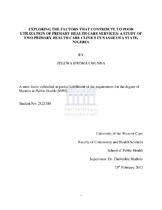| dc.contributor.advisor | Mathole, Thubelihle | |
| dc.contributor.author | Umunna, Zeluwa Ifeoma | |
| dc.date.accessioned | 2015-10-05T14:13:25Z | |
| dc.date.available | 2015-10-05T14:13:25Z | |
| dc.date.issued | 2012 | |
| dc.identifier.uri | http://hdl.handle.net/11394/4536 | |
| dc.description | Magister Public Health - MPH | en_US |
| dc.description.abstract | Introduction: Nigeria operates a three tiered health care delivery system with a large percentage of health care delivery vested at the primary care level. There has been over the years a continued effort by the government to decentralize health care service thereby increasing the range of services provided at the primary care level. Despite all these efforts there is still low utilization of primary health care services. This study therefore seeks to explore the factors that may be responsible for poor utilization of primary health service in Nasarawa State, Nigeria using two primary health clinics in Lafia local government area as case studies. Methodology: The study was carried out using the qualitative research methodology primarily using two data collection methods, the focus group discussions and individual interviews. A total of sixty participants were sampled, these consisted of ten members of staff, twenty non facility users and thirty facility users. Thirty individual interviews were conducted and four focus group
discussions held with staff and facility users at the two clinics. Facility users were randomly selected as they attended the clinic on the data collection days and were invited to participate in the study. Every second patient attending the clinic was selected for the focus group discussion and every third person for the interviews. The staff participants were randomly selected based on their availability while non-facility users were selected using snowballing. Data was analyzed using thematic analysis method. Findings: Two major themes emerged following data analysis; these were perception and experiences of facility users and barriers to utilization of health services. Users had a good perception of the services they received and are reasonably satisfied but certain deficiencies in the health care systems compromised the quality of service. Several factors were however hindering the utilization of these services and these include mainly institutional factors such as lack of infrastructure, equipment and staffing constraints; household factors such as cost of service and responsibility of decision making and other factors such as stigmatization and beliefs. Conclusion: Facility users of these clinics seem to have an overall good impression of services at the clinics; however there are certain fundamental deficiencies that need to be urgently addressed to improve the care provided at these clinics as these constitute barriers to utilization. These deficiencies such as the absence of electricity and water, lack of basic work equipment and inappropriate staff composition need to be addressed by the local government health department to ensure utilization and improved quality of service. | en_US |
| dc.language.iso | en | en_US |
| dc.publisher | University of the Western Cape | en_US |
| dc.subject | Primary health care | en_US |
| dc.subject | Health services | en_US |
| dc.subject | Antenatal care | en_US |
| dc.title | Exploring the factors that contribute to poor utilization of primary health care services: a study of two primary health care clinics in Nasarawa State, Nigeria | en_US |
| dc.type | Thesis | en_US |
| dc.rights.holder | University of the Western Cape | en_US |

